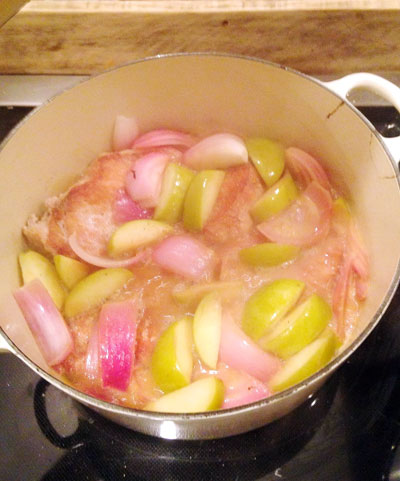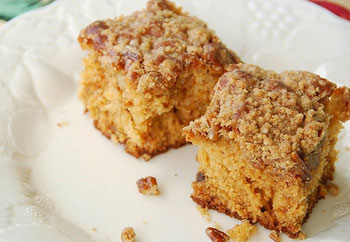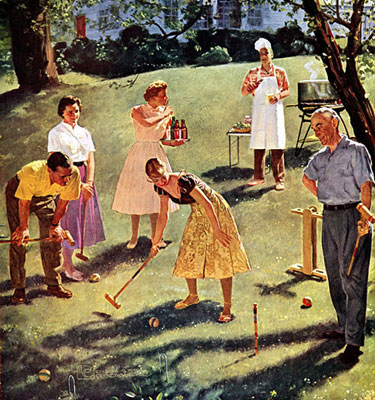 This is the time of year when pork and apples are synonymous with the cooler weather. What is it that makes us crave a dish like this in the Fall? It must be apple season, my favorite time of year. I am so glad to have the Honeycrisp apples back in the stores, they are truly my favorite.
This is the time of year when pork and apples are synonymous with the cooler weather. What is it that makes us crave a dish like this in the Fall? It must be apple season, my favorite time of year. I am so glad to have the Honeycrisp apples back in the stores, they are truly my favorite.
Pork cutlets are also perfect for family dinners. Kids seem to love them because they are mild and can be flavored mildly to their liking. They also take a very short time to cook, which means they will not turn into rubber. I like to keep pork cutlets in the freezer, they thaw quickly and meld easily with any sauces or gravies you might have on hand. Its perfect for those nights when time is of the essence.
This recipe makes enough for leftovers the next day.Take it to work with you in microwavable tupperware or slip the pork between two slices of bread for an awesome sandwich. The pork and the apples reheated well the next day.
Fall
Fall
Bring on the Plums: Poems About Food

How in this sweet
aftermath of everything the mind
should settle on plums
Geri Doran
“Blue Plums”
If poetry is all about the image, then it’s understandable why so many poets have written about food. Writing about food is like writing about a lover. The poet can—and does, joyously—explore all the senses. In “I Chop Some Parsley While Listening to Art Blakey’s Version of ‘Three Blind Mice,’” Billy Collins raises dicing herbs and vegetables while listening to jazz to a whole new level of food prep. Last semester, a student’s poem about warm pita and honey inspired my class to have a party where we drank tea and prepared and ate the subject of her poem.
Of all the food groups, however, it is fruit that has inspired the greatest outpouring. What better object to evoke sensations of sweetness and succulence? What better metaphor for the body? What better metaphor for the pleasures of poetry itself? Diane Wakoski’s “Ode to a Lebanese Crock of Olives,” one of her many food poems and a veritable cornucopia of shimmering ingredients, spills over to include “the gold of lemons” and “the still life of grapes.” In “A Step Away From Them,’ Frank O’Hara’s lunch includes “a glass of papaya juice.” That’s the “lunch poem” that ends with the lines “My heart is in my / pocket, it is Poems by Pierre Reverdy,”
Rosemary and Red Onion Apple Pork

Braising is probably next to roasting as my favorite cooking method for many things. Taking a meat and braising - not boiling it - is a delicate method to delicious cuts of meat! Gently infusing a gorgeous pork chop with apple cider is nothing short of divine. And this dish is easy and relativity quick! Wilt some kale in it and you've a one dish wonder!
I start with a Dutch oven and begin browning the pork chops on either side to form a slight crust. Salt and peppering the pork and high heat allows this. Searing them may be technically more apropos in culinary diction but y'all get me! Once the chops or even tenderloin are seared and crusted, I remove them from the pan onto a plate to rest.
Next, in the onion or two go to brown in the Dutch oven...No shock there folks! I use Mimi's adage, "butter for flavor, oil for temperature!" I really like to use red onions for this dish because they're color is so lovely - plus they caramelize fantastically! Brown the onions in some butter and oil and salt and pepper handsomely. This is the base of your meal y'all and adding salt at the end to me doesn't do salt and pepper their true justice of bringing out their companions' natural flavor.
Fresh Fig Tart with Honey-Orange Custard
 For a long time, the closest I had ever come to what I thought was a real fig was the dried kind or Fig Newtons. It wasn't until a family friend gave us a fig tree that I learned figs are actually fresh before they are dried. Not only that, but I discovered that fresh figs were worlds apart from the dried ones. We weren't the only family with a fig tree in the neighborhood. Italian and Portuguese neighbors had them too. That's because figs are native to the Mediterranean region, where they have been revered since ancient and biblical times. You can't not find mention of it in ancient Greek and Roman texts and of course the Bible's creation story. What would we have done without fig leaves?
For a long time, the closest I had ever come to what I thought was a real fig was the dried kind or Fig Newtons. It wasn't until a family friend gave us a fig tree that I learned figs are actually fresh before they are dried. Not only that, but I discovered that fresh figs were worlds apart from the dried ones. We weren't the only family with a fig tree in the neighborhood. Italian and Portuguese neighbors had them too. That's because figs are native to the Mediterranean region, where they have been revered since ancient and biblical times. You can't not find mention of it in ancient Greek and Roman texts and of course the Bible's creation story. What would we have done without fig leaves?
For a number of years we were lucky to have our own Garden of Eden with a flourishing fig tree in the backyard. With much ingenuity we were able to keep it protected through many winters until one year it finally didn't survive the cold. But I can never forget how anxious I was all summer long as I waited for the figs to ripen. It seemed to me they always took so long. But fig season is late September, so I had to learn to be patient because there was nothing I could do to speed up mother nature.
Pear and Cardamom Coffee Cake
 It's the same every autumn. Pears sit quietly in the wings while apples take center stage.
It's the same every autumn. Pears sit quietly in the wings while apples take center stage.
It's no wonder. Think about it. Do kids crave candied pears every Halloween? Do moms pack pear sauce in their kids' lunch boxes? Can something be as "all-American as pear pie"?
Pears are good. Some pears, such as Seckel pears – diminutive, super sweet fruits – are surprisingly good. Overall though, they just don't get the respect of apples.
When it comes to baking, however, pears blossom into something special. In fact, I have made this cardamom coffee cake with pecan streusel twice – once with apples and once with pears. You can tell which one I preferred.
Given their mild flavor, pears work beautifully with cardamom, a enticingly fragrant spice. Though a relative of ginger, cardamom has a unique flavor that is difficult to describe. It is intensely aromatic yet not overwhelming in flavor. It has notes of ginger, clove, and citrus, which is why it works so well when paired with fall fruits.
So, go ahead and give pears a little limelight.
More Articles ...
Welcome to the new One for the Table ...
Our Home Page will be different each time you arrive.
We're sure you'll find something to pique your interest...


